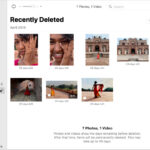Are you looking to free up storage space in your Amazon Photos account, switch to a different photo storage service, or simply declutter your digital life? Knowing How To Delete Photos From Amazon Photos is essential. This guide will walk you through various methods to remove images from your Amazon Photos, whether you want to delete just a few specific pictures or clear out your entire collection.
Deleting Individual Photos from Amazon Photos via App & Web
If you only need to remove a select number of photos from your Amazon Photos, the process is straightforward using either the mobile app or the web interface.
Using the Amazon Photos App (Mobile):
- Open the Amazon Photos App: Launch the app on your iPhone or Android device.
- Select Photos: Tap and hold the first photo you wish to delete. This will select the image and enable multi-selection mode.
- Choose More Photos (Optional): Tap on any additional photos you want to delete. Selected photos will typically be indicated with a checkmark or highlight.
- Delete: Look for the trash can icon, usually located at the top or bottom of the screen. Tap the trash icon to move the selected photos to the trash.
Using the Amazon Photos Web Interface (Desktop):
- Go to Amazon Photos Website: Open your web browser and navigate to https://www.amazon.com/photos. Sign in to your Amazon account if prompted.
- Select Photos: Click on each photo you want to delete. A checkmark or similar indicator will appear on selected images.
- Delete: Find the trash bin icon, usually positioned in the top menu bar. Click the trash icon to delete the selected photos.
How to Delete All Photos from Amazon Photos Efficiently
For users looking to delete all their photos from Amazon Photos, especially large libraries, there are a few techniques to speed up the process. While Amazon Photos interfaces don’t offer a simple “select all” for massive collections, these workarounds can help.
Quick Selection Tricks:
- Smartphone Drag Select: In the Amazon Photos mobile app, tap and hold the first photo. Without lifting your finger, drag downwards (or in the direction of more photos). This action will select a continuous range of photos quickly.
- Desktop Shift-Click Select: On your computer in the web interface, select the first photo in a range you want to delete. Then, hold down the Shift key and click on the last photo in the desired range. This will select all photos between the first and last click.
Limitations of “Select All” Button:
While the web interface does have a “Select All” button that appears after selecting a single photo, it’s important to note Amazon limits the number of photos you can select at once to 3,000. If you are viewing an album or folder with more than 3,000 photos, the “Select All” button will not be available.
The Most Effective Method: Deleting via Amazon Drive
The most efficient way to delete all your photos from Amazon Photos, especially in bulk, is to use Amazon Drive. Amazon Photos is essentially a user-friendly interface built on top of Amazon Drive storage. Your photos are stored within folders in Amazon Drive. By accessing Amazon Drive directly, you can bypass the selection limitations of the Photos interface.
Here’s how to delete all photos using Amazon Drive:
- Access Amazon Drive: Go to https://www.amazon.com/clouddrive/ in your web browser and log in with your Amazon account credentials.
- Open the Pictures Folder: Navigate to the “Pictures” folder within Amazon Drive. This folder contains the same photos you see in your Amazon Photos account.
- Select All Folders/Files: Look for a global checkmark option, often located at the top of the file list or folder view. Click this checkmark to select all items within the “Pictures” folder. Amazon Drive does not have the 3,000 item selection limit of Amazon Photos.
- Move to Trash: Once all items are selected, find the “Trash” or “Delete” icon (it may also be a right-click menu option). Choose to move all selected items to the trash.
This method works effectively both on the web interface and in the Amazon Drive App for iOS and Android.
Conclusion and Frequently Asked Questions
Deleting photos from Amazon Photos is a straightforward process, whether you’re removing a few images or your entire library. For bulk deletion, especially for large collections, using Amazon Drive is the most efficient and recommended method.
FAQ Section:
Can I recover deleted Amazon Photos?
Yes, whether you delete photos from the Amazon Photos app, web interface, or through Amazon Drive, they are moved to the trash/recycle bin. Photos remain in the trash for 30 days. During this period, you can recover them if you change your mind. After 30 days, they are permanently deleted.
Does deleting my Amazon Photos account delete all the photos?
Technically, there isn’t a separate “Amazon Photos account.” Amazon Photos is a service associated with your general Amazon account. Deleting your entire Amazon account would indeed remove access to Amazon Photos and all stored photos. However, this is an extreme measure if your goal is only to delete photos. It’s not recommended unless you intend to completely discontinue using all Amazon services.
What happens if I delete the Amazon Photos app from my phone or tablet?
Deleting the Amazon Photos app from your devices only removes the application itself. It does not delete your photos stored on Amazon servers. Your photos will remain safe in your Amazon Photos cloud storage and accessible through the web interface or by reinstalling the app.
How do I remove Amazon Photos from a Firestick or Fire Tablet?
Currently, directly deleting photos from the Amazon Photos app on Firestick or Fire Tablet devices is not supported. These devices are primarily for viewing content. To delete photos, you will need to use the Amazon Photos mobile app or the web interface on a computer or mobile browser, or use Amazon Drive as described above.

